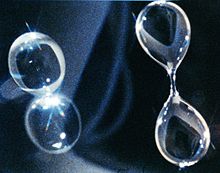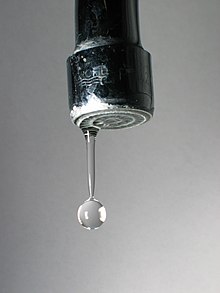drops
A drop denotes a shape on the one hand - and a mostly small body of liquid on the other. In the ideal case (state of rest, homogeneous liquid and external medium), the liquid body has a spherical shape. Only when the droplet is detached from the larger body of liquid, i.e. when the droplet is formed, does the droplet form briefly develop as an unstable state.
Teardrop shape
In common parlance, teardrop shape refers to a spatial shape that is spherical on one side and tapers to a point on the other. Contrary to popular belief, however, a drop of water only has approximately a "drop shape" shortly before it detaches from a body.
The drop shape often stands as a symbol for tears, blood and water drops and the like. In heraldry , the teardrop shape is also used as a symbol, see the article tears (heraldry) .
In knot science , a sack stitch is referred to as "teardrop-shaped" if the two loose ends form an angle of 90 ° to them when the fixed ends are loaded. The alternative to the teardrop shape is called a ring shape.
Physical Properties
A drop is a liquid body that is separated from its surroundings by a phase interface and its shape is largely determined by the interfacial tension . Because of the relatively low forces resulting from the interfacial tension, drops are limited to free fall and other forms of weightlessness or, under the conditions of terrestrial gravity, to a large ratio of volume to surface and thus to a small size, usually in the millimeter range. The environment can be a vacuum or a gas, a liquid or, in a partial space , a solid, as long as it is only partially wetted by the drop . Drops only form within the surrounding liquid if the two liquids are immiscible; an emulsion can also be present. A drop surrounded by a single phase is spherical at rest to the environment due to surface tension as the surface area is reduced in order to reduce the surface energy . A drop lying between two fluid phases is limited by two spherical caps for the same reason . Disturbances such as the detachment of a drop from a larger body of liquid lead to vibrations around the equilibrium form, e.g. B. between a flattened and an elongated deviation from the spherical shape, which, however, quickly decrease again due to internal friction.
A drop moving through a surrounding medium is flattened on the side in the direction of movement by the flow resistance. With increasing speed, the flattening becomes a dent, so that a kidney-shaped cross-section is created. As the speed increases further, the front boundary surface moves closer to the rear, so that an umbrella-shaped structure with a thickened border is created that quickly becomes unstable: the umbrella tears and the bordered torus splits into several smaller drops.
Drop formation
When a drop begins to detach itself from a body of liquid, a constriction occurs. But instead of simply tapering further so that a "teardrop shape" would arise, it stretches out in length. The result is a thread-like structure with an almost spherical drop at the end. Where the “thread” meets the drop, another constriction forms. If the viscosity of the liquid is high enough (higher than that of water), this constriction will also lengthen again. The higher the viscosity, the more often this process is repeated. At some point, however, this becomes unstable and the drop becomes detached from the thread. Other, smaller drops sometimes form from the thread.
Drops also form from a jet of water. A jet of water stretches as it falls, resulting in constrictions and bulges, which then contract into individual drops.
The detachment of a drop can easily be observed on a lava lamp (liquid / liquid phase interface) without further technical aids .
Raindrops
Rain is a form of precipitation , i.e. condensed water vapor . Raindrops do not have a “drop shape” either. With a droplet size of up to 0.5 mm, they are spherical. Normal raindrops 2 to 3 mm in diameter and weighing around 0.005 to 0.03 g are hemispherical at the top and dented at the bottom due to air resistance. As an intermediate stage there are drops that are flattened at the bottom. Large drops from thunderstorm rain (max. 9 mm) become unstable and tear through the air resistance. With a drop radius of 0.05 to 0.25 mm one speaks of drizzle .
The droplet size within the precipitation is statistically distributed, whereby a respective maximum can be assigned to different rain intensities.
pressure

The internal drop pressure depends on the surface tension (or general interfacial tension ) of the liquid (actually the liquid / gas interface) and the radius , as well as the air pressure . Strictly speaking, it is the difference between the capillary bending pressure and the external static pressure . The capillary bending pressure results in
- .
Small drops therefore have a high internal pressure . If the drop is not spherical, the two mutually perpendicular and extreme radii and the surface element on which it acts must be considered and preserved
- .
The surface tension of the water at 0.5 ° C (or 20 ° C) is approx. 0.0754 N / m (or 0.0728 N / m). At a temperature of 0.5 ° C, a typical cloud droplet with a diameter of 20 µm has an overpressure of approx. 151 hPa = 0.151 bar , while a drizzle raindrop with a diameter of 0.5 mm only has an overpressure of approx. 6 hPa.
The drop as a unit of measurement
A drop that comes off a cannula or pipette is an imprecise but widely used unit of measurement for small amounts of liquid, for example in the case of medicines or spices , as no further instruments are required for measurement. The actual size of a detached drop depends (see above) on the interfacial tension between the cannula and the liquid (reduced e.g. by surfactants ), on the cohesion of the liquid (e.g. gelling agent ) and on the shape of the opening during dosing and on the adhesion of the drop to the material of the tip of the dosing device. For aqueous solutions, around 15 to 20 drops are often given as one milliliter, whereas a raindrop can contain up to one milliliter. In pharmacy , the gtt metric (from Latin gutta , plural guttae ) is defined as 50 microlitres (50 µl), so-called drop counters for dosing medication result in 1 milliliter per 20 drops. As a historical unit of mass for pharmacists, one drop corresponds to around 0.05 grams (50 mg), corresponding to the mass of 50 µl of water.
See also
literature
- Ian Stewart: The teardrop shape . In: Spectrum of Science , 03/1996, p. 10.
Web links
Individual evidence
- ↑ Dortmund Data Bank: Surface Tension of Water www.ddbst.com, accessed on August 20, 2019
- ^ Emmanuel Villermaux, Benjamin Bossa: Single-drop fragmentation distribution of raindrops. In: Nature Physics. Volume 5, No. 9, 2009, pp. 697-702. bibcode : 2009NatPh ... 5..697V , doi: 10.1038 / NPHYS1340 .
- ↑ Jörg Mildenberger: Anton Trutmann's "Pharmacopoeia". Part II: Dictionary. Würzburg 1997, p. 2708.
















